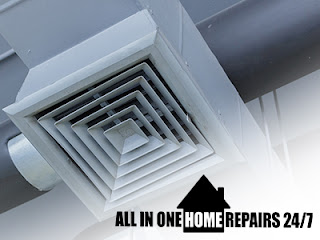HVAC | ALL IN ONE HOME REPAIRS 24/7
What Does HVAC Mean?
As your HVAC system ages it can lose efficiency which increases energy usage and cost or your heating and air condition system will just stop working altogether. Whether your heating and air conditioner system is in need of maintenance or repair, our professionally qualified, Heating and Cooling (HVAC) Repair Technician can promptly analyze the problem area and implement the necessary repairs
.
Cooling
An air conditioner's compressor contains a refrigerant. As it works, it sends this refrigerant through the system. As warm air blows across the coil that carries this refrigerant, the heat transfers to the refrigerant (cool always absorbs warm). A fan moves the cooled air through the ducting and out of vents that lead into the rooms of your house. The refrigerant returns to the compressor where the absorbed heat is moved outside. The refrigerant is then sent through the coil once again to continue the cycle.Heating
In a split system, the heater or furnace will be located away from the air conditioner. It may be in a garage or a basement. In a package unit, sometimes called a "gas pack", the heater is in the same cabinet as the air conditioner. Burners burn fuel and deliver it.Heat Exchangers
A blower that pushes the air along An exhaust flue In a manner similar to the coil described above in the cooling section, the burners heat up the fuel and send it through the heat exchanger. Cool air blows across the heat exchanger and absorbs the heat. The blower then sends it through the ducts and into the rooms of your house. The flue sends any exhaust gases safely out of your house. All of this is controlled by the thermostat as it communicates with your HVAC system's circuitry. It tells the system when to heat, when to cool, when to stop and when to run. Some systems control the temperature according to the whole house while others can control it room by room.Components Of An HVAC System
What is involved in installing an HVAC system? Know it's a genuine "system" with several independent components and functions that work together to produce an effect. At its most basic, an HVAC system consists of: An air conditioner that cools the air in your home. This works with an evaporator to make up the system that helps cool your home in the warm months. It's most often powered by electricity. A furnace that warms and circulates the air in your home. Furnaces are powered by many different sources such as electricity, solar, or geothermal, but most often they are powered by natural gas. Ducting that serves as a highway for the conditioned air to travel to your rooms.Ducting is normally made of stamped sheet metal, but expansion and contraction can cause leaks to form. Some contractors will install flexible ducting that won't wear out so easily. A thermostat that controls when the system turns on and off. Thermostats can be manual, programmable, and some work wirelessly so you can control them remotely from your smartphone. There are other components of an HVAC system that may or may not be present in a standard installation. These features are: A germicidal UV light: This feature sterilizes the air, purifying to a level often found in hospitals. While it's comfortable to breathe clean air, for those with conditions or compromised immune systems, it can be a very important part of their HVAC system.
A central humidifier: This helps maintain the level of humidity in the air in your home. Scientists have determined that most people are comfortable at 50% humidity. This keeps the air from being too dry or too humid and cuts down on static electricity. It can also help people with respiratory conditions such as COPD or chronic asthma. An energy recovery ventilator: This component helps improve the air inside your home by swapping it out with fresh air from the outside. During the winter months when houses are closed up to keep out the cold, the air inside becomes a handy way for colds and flu to infect an entire family.
By circulating outside air inside, the health of your family will have a better chance. An electronic air cleaner: This additional filtration helps keep pollen and other allergens from getting into your system and circulating throughout the house. See how much it costs to install a whole house air purifier or cleaner.









Comments
Post a Comment